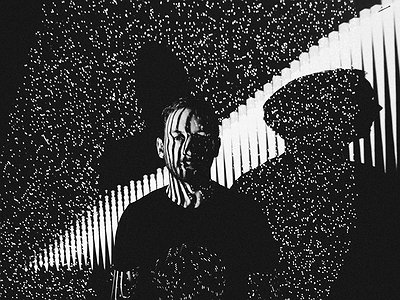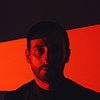Could you describe your creative process on the basis of a piece or album that's particularly dear to you, please?
I like to start with a clear feeling and/or visual scene/structure. That is the basic form which I find is best to work from, and initially informs a chord progression or melodic structure, along with initial synth patch design. For the track “Hope” on the new LP, I started with that feeling of what hope is, and found that I could convey it using a very simple structure whereby a chord sequence played once, then there was a long single chord with a slowly evolving patch, opening up. So it’s clear that the piece is moving towards something, and we already had a hint of it from the initial single chord sequence teaser, so it’s literally setting up the feeling of hope and anticipation about where the music is going, as well as capturing something about the bittersweet form of the feeling itself, hoping for something better.
Where did the ideas come from, how were they transformed in your mind, what did you start with and how do you refine these beginnings into the finished work of art?
In the case of "Hope", the idea came from the overall project about the mind, called “one hundred billion sparks”, referring to the one hundred billion neurones inside our heads which create all of our experience. I knew I wanted to make a project around that rough idea, so I booked a month away on my own, turned off my phone and emails, and spent the time trying to look inwards for the basics of what my mind created. Hope was one important aspect of that, so became one track on the album.
There are many descriptions of the ideal state of mind for being creative. What is it like for you? What supports this ideal state of mind? Are there strategies to enter into this state more easily?
Absolute focus is most important for me, which means no distractions. That’s why I do most of my music work at night when everyone else is asleep and I’m not getting any phone calls or being expected to be doing anything else. Perhaps there’s something about the state of mind late at night which lends itself to the sort of music I make, also well suited to late night listening.
How is playing live and writing music in the studio connected? What do you achieve and draw from each experience personally? How do you see the relationship between improvisation and composition in this regard?
They are quite different for me, because I’m not a traditional musician, I can’t play pieces live. My production process is very messy and full of chaos and mistakes. I spend a long time tidying up this chaos to create something succinct. So for live shows I don’t want to show that mess, I use rendered pieces of audio rather than live playing, and instead I spend my time working on larger scale aspects of the live show mainly, such as the visuals, which I usually play myself, the overall track structures and the form of the set, trying to interact with the audience and find what works. This approach gives me a lot of flexibility over what I play, I never have a set list or pre-planned track order, and I never play the same set twice. I have access to 100 or more different tracks even in the live visual show. So it’s a little like DJing, which makes sense, as that’s my background, rather than coming from a traditional music background playing instruments etc. This approach also means I go very effects heavy, which is also linked to my production approach. Both audio and visual effects. I’m basically jamming with lots of audio and visual clips and effects, and I have a nice system which allows me to play both in sync from a single control source.
How do you see the relationship between the 'sound' aspects of music and the 'composition' aspects? How do you work with sound and timbre to meet certain production ideas and in which way can certain sounds already take on compositional qualities?
Yeah it’s something I’ve thought about a lot over the years. It’s easy to imagine that melody/chord structure defines almost everything about how something feels, but actually, the same melodies or chords can feel totally different based on the synth patch/timbre, and that really needs to be matched up with the concept/feeling from the start, if the process is not to end in failure. Sometimes I still get this wrong and embark on a composing process with the wrong patch, then struggle away making nonsense until I realise it’s the patch which is wrong. The more effective approach I’ve found is to set aside specific time for working on patches only, just designing nice timbre’s and sounds which may or may not prove useful in future. Then at least I have something quick to draw on and when I’m feeling the urge to express something. The problem is that if I leave that patch design phase until I’ve got the emotive expressive urge, that emotion can easily get lost in the process of trying to build a patch to match it, as you start to pollute your feelings with all the new patches you’re working through en-route. So I find it’s best to have as many as possible pre-made patches which suit common themes in whatever sort of music or feelings you tend to work with.
Our sense of hearing shares intriguing connections to other senses. From your experience, what are some of the most inspiring overlaps between different senses?
The links between hearing and sight are a major part of everything I do. The more obvious links being that these days nearly every track I write is set to a visual form which I then collaborate with visual artists to create. But going back before that type of work, I was always obsessed with psycho-acoustics and spatiality in sound, creating that feeling with stereo headphones that sounds are moving around you, and that you are immersed inside the piece of music. I still spend a lot of my time working on those aspects of every track, using binaural recordings, simulated binaural sounds, phasing and panning effects, and different widening plugins, along with constant enveloping pads and bass chords which sort of wrap you up in their warmth, that has been a constant obsession for me. Then there’s 4D sound, Dolby Atmos and other forms of live surround sound which I’ve used over the years, for translating these same ideas to a live setting.
What does this tell us about the way our senses work?
That they’re not as separate as we might think. It’s amazing how much spatial information you receive from your hearing without realising. Just try the “binaural hairdresser” on youtube with your eyes closed and decent pair of headphones on for a fun demonstration.



